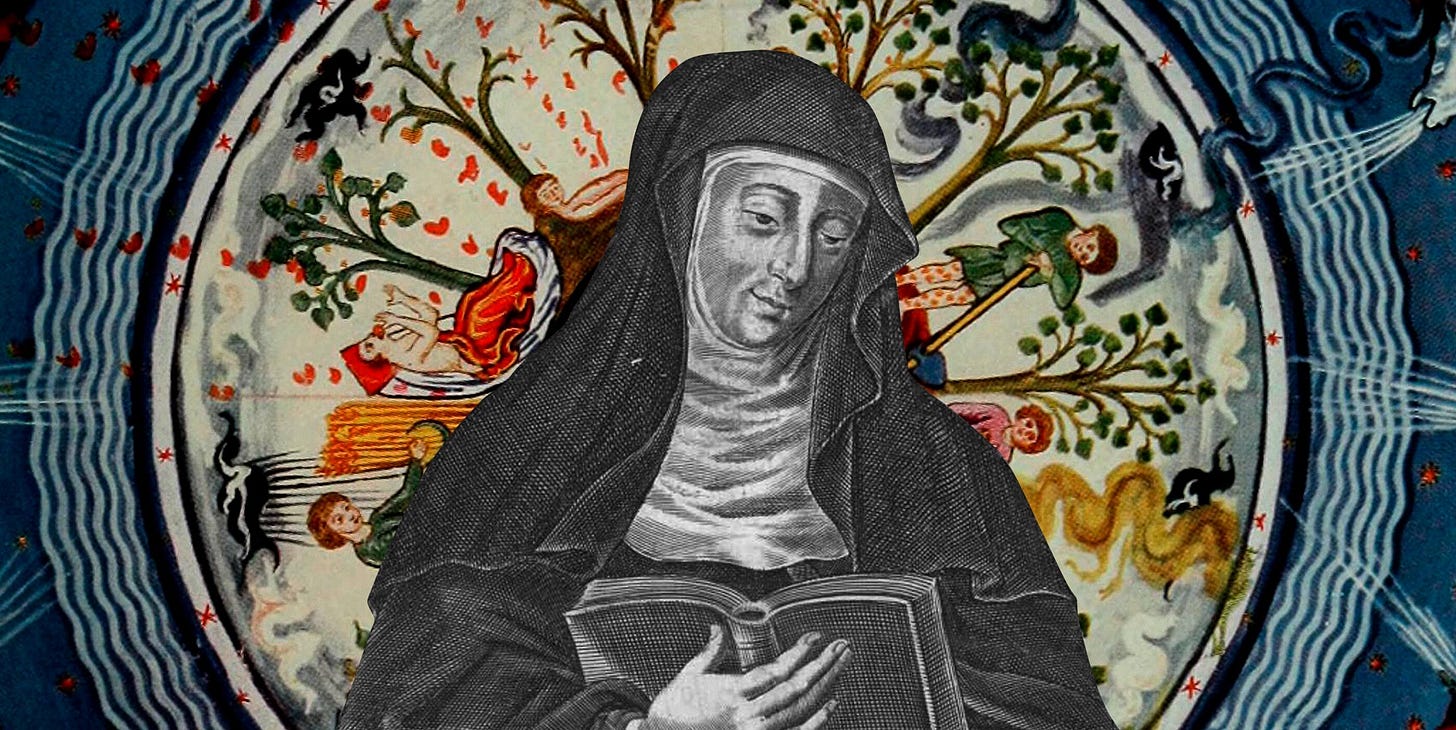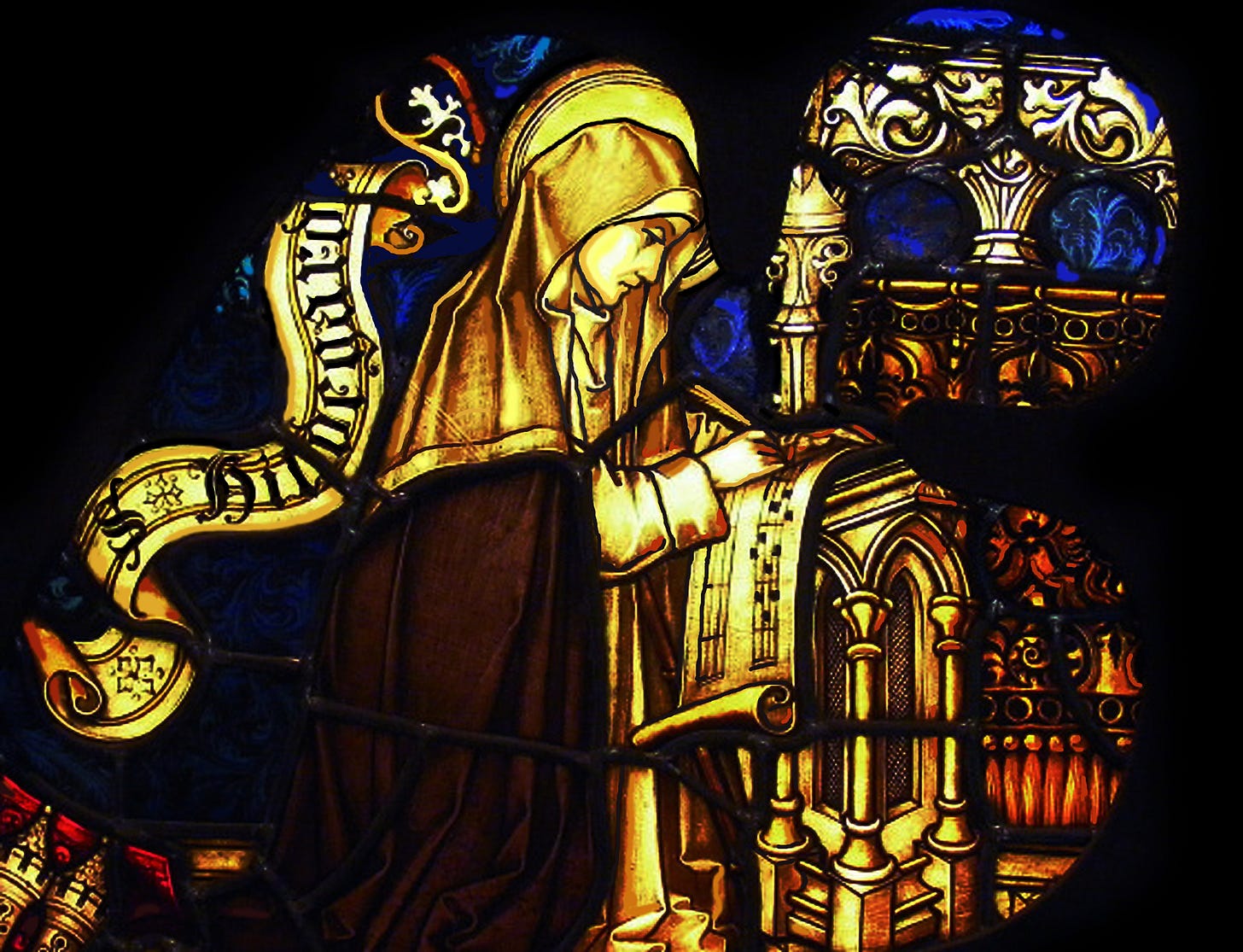It was not until 1979 that the reputation of that remarkable medieval woman, Hildegard of Bingen (1098 - 1179) — Benedictine abbess, Christian mystic and visionary, herbalist, artist, proficient in philosophy, literature, and all the sciences of her day, and a composer of magnificent sacred music — was restored after centuries of neglect. Before that year (the 800th anniversary of her death), knowledge about her and her oeuvre had been mostly confined to the research work of a few academic specialists. “Today we think of Hildegard as one of the first identifiable composers in the history of Western music (most medieval composers were ‘Anon’),” writes Owen Hopkin for Classic FM (see the article here.) “But there were no mentions of her music in any reference book before 1979 and she barely warranted an entry in the 1990 edition of The New Grove Dictionary of Music.” Happily, that long period of neglect has ended, and Hildegard has enjoyed some popularity. Her music (see below) has been recorded, films have been made about her, her writings translated, and numerous books detailing her fascinating and productive life have been written. (A particularly good online summary of her life can be read here, at the World History Encyclopedia site.)
Below, you will find links to hours of Hildegard’s music, followed by a link to a website that provides translations of the texts she wrote for her compositions.
Before that, directly below, I have included a stimulating 2012 lecture by the Rev’d Prof. June Boyce-Tillman (described by Wikipedia as “a prominent British academic specialising in music, spirituality and theology, particularly women's role in church music”), regarding Hildegard’s life, theology, and mysticism. It was presented at St. Paul’s Cathedral, London, and runs about 56 minutes.
The recordings that follow were performed by the Sequentia Ensemble for Medieval Music. On their website, they have this to say about their ongoing project of presenting Hildegard’s music to the world afresh (the text can be found here).
Since the early 1980’s, Sequentia’s name has been closely linked with the music of Hildegard von Bingen (1098-1179), the visionary abbess and healer whose spiritual compositions are among the most astonishing and unique creations from the dynamic milieu of 12th-century Benedictine monasticism. Hildegard referred to her songs collectively as ‘The Harmonious Music of Celestial Revelations’ (symphoniae harmoniae celestium revelationum), a title meant to indicate their divine inspiration as well as the idea that music is the highest form of human activity, mirroring the ineffable sounds of heavenly spheres, angelic choirs and the individual human soul. Between 1151 and 1158 this visionary ‘Sibyl of the Rhine’ began to collect her musical creations, most of them intended to be sung by the sisters of her convent at the Rupertsberg (on the Rhine at Bingen), as a complement to the traditional Gregorian chant sung during liturgical and other functions. Anyone who has sung her music knows that it counts among the most sublime, virtuosic and demanding vocal repertoires ever created. “It is said that you are raised to Heaven, that much is revealed to you, that you bring forth great writings, and discover new manners of song…” wrote Master Odo of Paris in 1148. Then, as now, Hildegard was admired for fearlessly exploring the soul’s place in the cosmos and giving it voice through her unique musical vision.
Sequentia was among the first vocal ensembles to revive Hildegard’s music in our time, working closely from the medieval manuscript sources and employing concepts of performance practice which would have been known to the abbess and her Benedictine sisters in the 12th century. Under the general direction of the late Barbara Thornton, and working closely with musicologists and philologists (especially Leo Treitler, Peter Dronke and Barbara Stühlmeyer) many of the world’s foremost vocalists and instrumentalists in historical music performance joined Sequentia to perform and record Hildegard’s works on a regular basis between 1982 and 2012... From the beginning, the entire project was supported generously by the West German Radio in Cologne (producers Alfred Krings and Klaus L Neumann), which co-produced most of the recordings on the Deutsche Harmonia Mundi label. In addition to recording, the ensemble toured widely to critical acclaim in Europe, North America, Australia and Japan.
On Spotify:
On YouTube:
Lastly, on this site, you can find translations of Hildegard’s texts by clicking here.






Saint Hildegard’s music is, not to be too flippant about it, as if the angels descended and held your heart. Her biography is incredible - she was a master of many fields. Thanks for sharing.